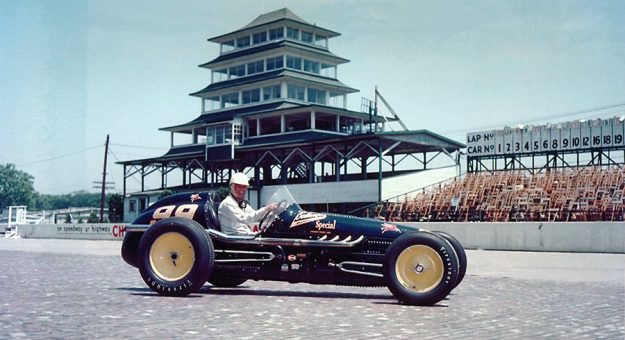BALLSTON SPA, N.Y. — New Yorker Lee Wallard rose from the rough-and-tumble, dusty fairgrounds speedways of the Northeast to the pinnacle of auto racing — victory lane at Indianapolis Motor Speedway.
He won the 1951 Indianapolis 500 in the Belanger No. 99 with a time of 3 hours, 57 minutes and 38 seconds and an average speed of 126.244 mph, leading Mike Nazaruk, Jack McGrath, Andy Linden, Bobby Ball and Henry Banks to the checkered flag.
Wallard first ran the Brickyard in 1948, with the 37-year-old rookie pioneering a new racing groove by taking the Iddings dirt car out to the wall on the short chutes and diving into the corner while others hugged the inside all the way through the turns.
A one-time bulldozer operator and a World War II Navy veteran, Wallard was a fearless racer. “No car could hold him,” recalled car owner Carl Boss. “He was upside down at the Altamont Fairgrounds a lot of times.”
At that point, he’d already missed much of the 1941 season after suffering a broken pelvis in a crash.
After the war, his hard-charging style took Wallard to the AAA Eastern sprint car circuit, with occasional forays into Championship racing. After running the Iddings car at Indianapolis in ’48, Wallard moved to the former Wilbur Shaw Maserati in ’49 but suffered a mechanical failure while leading.
In 1950, he drove Lou Moore’s Blue Crown Special, qualifying 23rd and finishing sixth when rain ended the race at 345 miles.
Tony Bettenhausen, who drove the No. 99 car on the Championship Trail in 1949 and ’50, moved to the Blue Crown team for Indianapolis in 1951 and recommended Wallard as his replacement.
Wallard and chief mechanic George Salih put the Belanger car, a “stretched” sprinter, into the middle of the front row for the ’51 race, then ran the race like a dash rather than an endurance contest.
After battling polesitter Duke Nalon and Jack McGrath most of the way, Wallard told the Schenectady Gazette, “It was pretty tough out there. It seemed there was never a time when someone wasn’t pressing me.”
“They’re crazy” McGrath declared after yielding to a relief driver. “They’re running like it was a dirt-track race.”
At the checkered flag, only six cars were left with the brakeless Wallard running two “slow down” laps, then coasting to a stop in victory lane. He went into the record book as the first to run the 500 miles in less than four hours.
Patches of skin were worn off Wallard’s hands and his upper body was raw from his coveralls whipping in the wind against his bare chest, as the hot day had dictated going to the post with no underwear in an effort to stay cool. A post-race weigh-in found him some 15 pounds lighter from the beating his body took.
“Winning the race is the greatest thing that can happen to a driver” Wallard told the Gazette. “It’s star-gazing stuff when you’re trying and missing. And now that I’ve made it, it’s hard to believe.”
Unfortunately, Wallard’s luck was about to change. Four days later, he ran a AAA sprint car race at the Reading (Pa.) Fairgrounds, having promised promoter Sam Nunis he’d participate before winning at Indianapolis.
His car caught fire on the last lap and Wallard steered it past the pits to avoid injuring anyone else before jumping out with his shirt and pants on fire. Ten days in the Reading hospital were followed by months more in the Albany Veteran’s hospital. He endured some 35 skin grafts before his October release.
When the No. 99 was displayed at the Saratoga Automobile Museum, a nephew of Wallard told a sobering tale of how a physician asked him and his brother to donate skin off their chests for skin grafts on their uncle, assuring them that it would not hurt.
He went on to relate that it did, indeed, hurt, but the duo wrapped their oozing chests in sanitary napkins, put on their coveralls and went back to work as truck mechanics.
Following a lengthy rehabilitation, Wallard returned to the speedway in 1954, practicing at speeds that would have put him in the race, but he retired prior to qualifications. Wallard moved to Tampa, Fla., and served as a Champion Spark Plugs representative for many years.
Health problems triggered by not being able to perspire due to the extensive skin grafts hampered Wallard for the rest of his life. He died on Nov. 29, 1963, at the age of 52 and was buried in the Prospect Cemetery in Guilderland, N.Y., not far from the racing-themed tavern and restaurant he’d owned at one time.
